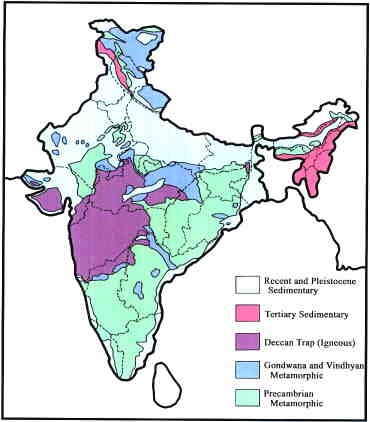The Deccan Traps, a large volcanic province in west-central India, are known for their vast expanse of igneous rock formations that resulted from massive volcanic eruptions around 66 million years ago. This region, covering parts of Maharashtra, Gujarat, Madhya Pradesh, and Karnataka, has significant natural resource potential. Here are the key natural resources found in the Deccan Trap:
1. Mineral Resources:
The Deccan Traps are rich in various minerals due to their volcanic origin, offering valuable resources for multiple industries.
- Basalt:
- The Deccan Traps are primarily composed of basalt, a hard and dense volcanic rock that is widely used in construction, particularly for building roads, railway ballast, and as an aggregate in concrete. Basalt is also used for making dimension stones.
- Bauxite:
- The region is known to have deposits of bauxite, the primary ore for aluminum. Bauxite found in the lateritic soils over the Deccan Traps is extensively mined in regions like Maharashtra and Gujarat.
- Iron Ore:
- The Deccan region contains iron ore deposits in areas like Maharashtra, although not in very large quantities. These iron ore deposits are associated with the weathering of basalt.
- Copper and Manganese:
- Some areas in the Deccan Trap region, particularly in Maharashtra, have small deposits of copper and manganese ores. These are essential for the production of alloys and in the steel industry.
- Zeolites:
- The Deccan Traps are famous for their extensive deposits of zeolites, a group of silicate minerals with unique adsorption and catalytic properties. Zeolites are used in water purification, agriculture (as soil conditioners), and industrial applications like petrochemical cracking.
2. Soil Fertility and Agricultural Potential:
- Black Soil (Regur Soil):
- One of the most important resources of the Deccan Trap region is its fertile black soil, also known as regur soil, formed from the weathering of basaltic rock. This soil is rich in iron, magnesium, and other minerals, and has excellent moisture retention capacity.
- Black soil is highly suited for growing cotton, which is why the Deccan region is one of India’s key cotton-producing areas, earning it the title of the “Cotton Belt”. Other crops like sorghum (jowar), millets, wheat, and oilseeds are also cultivated here.
3. Groundwater and Hydrological Potential:
- Groundwater Storage:
- The basaltic formations of the Deccan Traps are characterized by fractured rock aquifers, which can store substantial amounts of groundwater in the cracks and cavities of the basalt layers. These aquifers are crucial for providing water in the semi-arid regions of the Deccan Plateau.
- However, the quantity and availability of groundwater can vary depending on the thickness and porosity of the basalt layers.
- Waterfalls and Rivers:
- The step-like structure of the Deccan Traps gives rise to numerous waterfalls and fast-flowing rivers, such as the Godavari, Krishna, Narmada, and Tapti, which are vital for irrigation and hydroelectric power generation.
4. Geothermal Energy Potential:
- Due to the volcanic origin of the Deccan Traps, the region has some potential for geothermal energy exploitation. There are geothermal hot springs, such as those in Maharashtra’s Tattapani region, which could be developed for energy production or tourism.
5. Tourism and Geographical Heritage:
- The Deccan Traps are a significant geological feature of the Indian subcontinent and attract researchers and tourists alike. The region’s geological importance and its dramatic landscapes, like the Ajanta and Ellora caves (carved into Deccan basalt), have immense potential for geo-tourism and cultural tourism.
6. Petroleum and Natural Gas Prospects:
- Some geological surveys have indicated that the Deccan Traps region may hold potential for petroleum and natural gas reserves in the deeper strata beneath the basalt layers. Exploration in certain parts of the region is ongoing, though large-scale extraction has not yet been confirmed.
Conclusion:
The Deccan Trap region is rich in mineral, agricultural, hydrological, and geological resources, offering diverse opportunities for industries ranging from construction to agriculture and energy. Its fertile black soil supports intensive agriculture, particularly cotton cultivation, while its basalt formations provide construction materials and minerals like bauxite and zeolites. With potential for groundwater development, geothermal energy, and tourism, the Deccan Trap plays a significant role in India’s economy and environmental sustainability.


